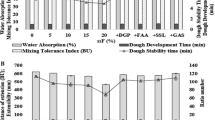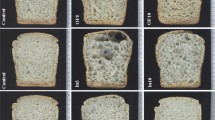Abstract
Effect of replacement of wheat flour with a combination of soy protein isolate, oat bran and chickpea flour (SPOBCP) at the levels of 20%, 40% and 60% and addition of combination of additives such as fungal α-amylase, dry gluten powder, sodium stearoyl-2-lactylate, hydroxypropylmethylcellulose (CA) on the rheological and nutritional characteristics of bread was studied. Use of SPOBCP decreased farinograph dough stability, increased pasting temperature, decreased cold paste viscosity and overall quality score of bread. Scanning electron microscopy images showed higher degree of disruption of protein matrix in bread dough with 60% SPOBCP than 20% and 40% SPOBCP. Addition of 60% SPOBCP resulted in flat, uneven shaped bread with an overall quality score of 38 when compared with 54, 81 and 91 for breads with 40%, 20% and 0% SPOBCP, respectively. However, use of CA increased the strength of the dough and improved the overall quality of bread with 40% SPOBCP. Nutritional profile of bread with 40% SPOBCP + CA showed higher protein, in vitro protein digestibility, total dietary fibre, resistant starch, β-glucan and lower starch hydrolysis index than control bread.




Similar content being viewed by others
References
AACC. (2000). Methods 44–15, 08–01, 38–10, 56–60, 56-81B. Minnesota: Approved methods of the American Association of Cereal Chemists, AACC.
Akeson, W. R., & Stahmann, M. A. (1964). A pepsin pancreatin digest index of protein quality evaluation. Journal of Nutrition, 83, 257–261.
Anderson, J. W., Story, L., Sieling, B., Chen, W.-J. L., Petro, M. S., & Story, J. (1984). Hypocholesterolemic effects of oat-bran or bean intake for hypercholesterolemic men. American Journal of Clinical Nutrition, 40, 1146–1155.
Asp, N. G., (1992). Resistant starch: proceedings from the second plenary meeting of EURESTA: European FLAIR concerted action no. 11 on physiological implications of the consumption of resistant starch in man. European Journal of Clinical Nutrition, 46, S1.
Asp, N. G., Johansson, C. G., Hallmer, H., & Siljeström, M. (1983). Rapid enzymatic assay of insoluble and soluble dietary fiber. Journal of Agricultural and Food Chemistry, 31(3), 476–482.
Bajwa, U. (1990). Effects of glyceryl monostearate and α-amylase supplements on rheological and breadmaking properties of medium protein wheat flour. Journal of Food and Agriculture, 52(1), 97–105.
Bell, D. A. (1990). Methylcellulose as a structure enhancer in bread baking. Cereal Foods World, 35, 1001–1006.
Chung, O. K., & Tsen, C. C. (1975). Functional Properties of surfactants in relation to flour constituents in a dough system. Cereal Chemistry, 54, 832–838.
Chung, H. J., Shin, D. H., & Lim, S. T. (2008). In vitro starch digestibility and estimated glycemic index of chemically modified corn starches. Food Research International, 41, 579–585.
Dow Chemical. (2002). METHOCEL cellulose ethers: Technical handbook. Midland, MI: The Dow Chemical Company.
Dubois, C. (1978). The practical application of fiber materials in bread production. Baker’s Digest, 52, 30–33.
Ghavidel, R. A., & Prakash, J. (2007). The impact of germination and dehulling on nutrients, antinutrients, in vitro iron and calcium bioavailability and in vitro starch and protein digestibility of some legume seeds. LWT-Food Science and Technology, 40, 1292–1299.
Gómez, M., Oliete, B., Rosell, C. M., Pando, V., & Fernández, E. (2008). Studies on cake quality made of wheat–chickpea flour blends. LWT-Food Science and Technology, 41, 1701–1709.
Goñi, I., García-Alonso, A., & Saura-Calixto, F. (1997). A starch hydrolysis procedure to estimate glycemic index. Nutrition Research, 17, 427–437.
Gopalan, C., Sastri, R. B. V., Balasubramanian, S. C., Rao, N. B. S., Deosthale, Y. G., & Pant, K. C. (1989). Nutrive value of Indian foods. Hyderabad, India: National Institute of Nutrition, Indian Council of Medical Research.
Higgins, J. A. (2004). Resistant starch: metabolic effects and potential health. Journal of AOAC International, 87(3), 761–768.
Indrani, D., Prabhasankar, P., Rajiv, J., & Venkateswara Rao, G. (2003). Scanning electron microscopy, rheological characteristics, and bread-baking performance of wheat-flour dough as affected by enzymes. Journal of Food Science, 68, 2804–2809.
Indrani, D., Swetha, P., Soumya, C., Rajiv, J., & Rao, V. (2011). Effect of multigrains on rheological, microstructural and quality characteristics of north Indian parotta—an Indian flat bread. LWT-Food Science and Technology, 44, 719–724.
Krishnan, P. G., Chang, K. C., & Brown, G. (1987). Effect of commercial oat bran on the characteristics and composition of bread. Cereal Chemistry, 64(1), 55–58.
Lazaridou, A., Duta, D., Papageorgiou, M., Belc, N., & Biliaderis, C. G. (2007). Effects of hydrocolloids on dough rheology and bread quality parameters in gluten-free formulations. Journal of Food Engineering, 79(3), 1033–1047.
Lorimer, N. L., Zabik, M. E., Harte, J. B., Stachiw, N. C., & Uebersax, M. A. (1991). Effect of navy bean protein flour and navy bean globulin(s) on composite flour rheology, chemical bonding, and microstructure. Cereal Chemistry, 68, 213–220.
McCleary, B. V., & Monaghan, D. A. (2002). Measurement of resistant starch. Journal of Association Official Analytical Chemistry International, 85, 665–675.
Mohamed, A. A., Rayas-Duarte, P., Shogren, R. L., & Sessa, D. J. (2006). Low carbohydrates bread: formulation, processing and sensory quality. Food Chemistry, 99(4), 686–692.
Rojas, J. A., Rosell, C. M., & Barber, C. B. (1999). Pasting properties of different wheat flour-hydrocolloid systems. Food Hydrocolloids, 13, 27–33.
Rosell, C. M., Rojas, J. A., & Benedito de Barber, C. (2001). Influence of hydrocolloids on dough rheology and bread quality. Food Hydrocolloids, 15(1), 75–81.
Ryu, C. H. (1999). Study on bread making quality with mixture of waxy barley wheat flour. 1. Rheological properties of dough made with waxy barley–wheat flour mixture. Journal of Korean Society of Food Science and Nutrition, 28, 1034–1043.
Serna-Saldivar, S. O., Lopez-Ahumada, G., Ortega-Ramireza, R., & Abril Dominguez, R. (1988). Effect of sodium stearoyl-2-lactylate on the rheological and baking properties of wheat bread fortified with defatted soybean and sesame meal. Journal of Food Science, 53(211–214), 230.
Shuey, W. C., & Tipples, K. H. (1980). The amylograph handbook. St. Paul, MN: American Association of Cereal Chemists.
Singh, N., Harinder, K., Sekhon, K. S., & Kaur, B. (1991). Studies on the improvement of functional and baking properties of wheat–chickpea flour blends. Journal of Food Processing Preservation, 15, 391–402.
Sosulski, F. W., & Wu, K. K. (1988). High fiber breads containing field pea hulls, wheat, corn, and wild oat brans. Cereal Chemistry, 65(3), 186–191.
Stauffer, C. E. (1990). Enzymes. In C. E. Stauffer (Ed.), Functional additives for bakery foods (pp. 125–156). New York: Van Nostrand Reinhold.
Steel, R. G. D., & Torrie, J. H. (1980). Principles and procedures of statistics. New York: McGraw-Hill.
Utrilla-Coello, R. G., Osorio-Díaz, P., & Bello-Pérez, L. A. (2007). Alternative use of chickpea flour in breadmaking: chemical composition and starch digestibility of bread. Food Science and Technology International, 13(4), 323–327.
Wang, J. S., Rosella, C. M., & Carmen, B. B. (2002). Effect of the addition of different fibres on wheat dough performance and bread quality. Food Chemistry, 79, 221–226.
Acknowledgements
The authors are greatly indebted to Mr. K. Anbalagam, CIFS, CFTRI, Mysore for his help in carrying out scanning electron microscopic studies.
Author information
Authors and Affiliations
Corresponding author
Rights and permissions
About this article
Cite this article
Dhinda, F., A., J.L., Prakash, J. et al. Effect of Ingredients on Rheological, Nutritional and Quality Characteristics of High Protein, High Fibre and Low Carbohydrate Bread. Food Bioprocess Technol 5, 2998–3006 (2012). https://doi.org/10.1007/s11947-011-0752-y
Received:
Accepted:
Published:
Issue Date:
DOI: https://doi.org/10.1007/s11947-011-0752-y




